
This year, I am looking at how LEGO Themes developed from those early days in 1978. Castle, Town and Space all developed in their own way, and they certainly don’t look the same today as they did back then! So as we take a ramble down Memory Lane, let’s look at how things were and how they have changed: scale, elements, colours and more.
For our first theme to track through time, I am looking at the theme that set out to represent the world around us: Classic Town. Over the years, this theme has evolved, with the LEGO City theme of today looking very different, yet incorporating similar subject matter. This investigation covers material released over more than 40 years. So it might take a little while. In this post, I shall cover LEGO Town from its origins in 1978 to 1990. Next time, we shall look at the System era (1992-1999). Finally, in the future, we will examine LEGO City and see how that theme compares with those in the early days.
Along the way, we will examine the scale, building techniques, elements and more. There will be lots of pictures, sure to provoke a degree of nostalgia. I’d love to know which sets you feel fondly about and what you enjoyed about these themes.
Playing in the Real World: From LEGO Town to LEGO City:
From the earliest days, LEGO Bricks have been used to depict aspects of the real world. From the earliest LEGO Town Plan to today’s LEGO City sets, there have always been LEGO Sets designed to represent the world kids will see around them. However, over the 43 years since the Minifigure was first released, there has been a decided shift in the content, as well as the way that stories are told in LEGO sets: In the early days, LEGO® Town was a simple place: there were lots of Policemen, but no criminals. Lots of firefighters, but no flames. Cars and trucks were all four studs wide, and we had a variety of other buildings: garages, snack bars, and houses.
Flash forward to 2021, and LEGO® City is a large, brash place: Garages, police stations and Firestations appear on every corner, and if you want to buy another type of business for your town, you are looking at one of the omnibus City Centre type sets. A four stud wide vehicle: it’s either a quad bike or a tire with a paddle. And what of residential space? Two houses in 15 years! Seriously – where do people live? But I am getting ahead of myself…
How did a LEGO® Town Look In A World Without Minifigures?
From 1969, LEGO sets depicting buildings and vehicles of a particular scale were grouped in the catalogue under the theme of LEGOLAND. These sets included not only town type sets but also a Western layout. Thus, we saw our first emergency vehicles released in 1969, with fire stations and police stations released around 1972. Vehicles built in a similar style were also available for purchase as separate sets. A little later, we saw the ‘Stage Extra’ figure introduced. Although we did not see a fire station with these motionless, faceless figures, they helped to populate our towns at this time.
Ultimately, the Minifigure was introduced in 1978. A new fire station and police station followed. Why were these figures always smiling? Perhaps this is because there were no crooks to chase and no fires to extinguish? Cause or effect? You be the judge!






1978 The Classic Era Arrives: With Minifigures Setting The Stage.
The arrival of the Minifigure was the most dramatic change introduced in 1978: at last, we were able to get some people to live in our town. The first ones released required a sticker for their torso decoration – but printing arrived soon after, in 1979.
Apart from the presence of minifigures, several elements define the design of these simple vehicles, compared with earlier ones: One is the use of dedicated wheel arches. Another is the introduction of transparent 1×1 elements – particularly the 1×1 round bricks, in transparent, round bricks.




It was not always possible for Minifigures to sit in this initial wave of vehicles. Ultimately, it probably did not affect play, but it certainly felt a little disjointed if you were interested in scale modelling. Most of the vehicles released at this time also came with ‘re-skinned’ versions: fire, police, auto repair, and paramedics would all travel in cars of similar designs. It is helpful to note that cars still have the printed 1×4 headlamp/grille brick at this stage, a hangover from the early 70’s. In time, they shall a brick-built arrangement will replace them.
Here are some examples from the 1978 Town sets:






These sets were the perfect ‘Pocket money’ impulse buy – inexpensive and with sufficiently versatile parts to pick one up every couple of weeks when out shopping late on a Friday night (as my memory seems to go). Oddly enough, some of these sets were not released in the USA (with a different set number) until 1980.
It Wasn’t Just Emergency Services
In these early years, it was more than just police departments and fire brigades. There were plenty of other industries represented: we saw the bus station, a garage, and many road workers. Even somewhere to call home.



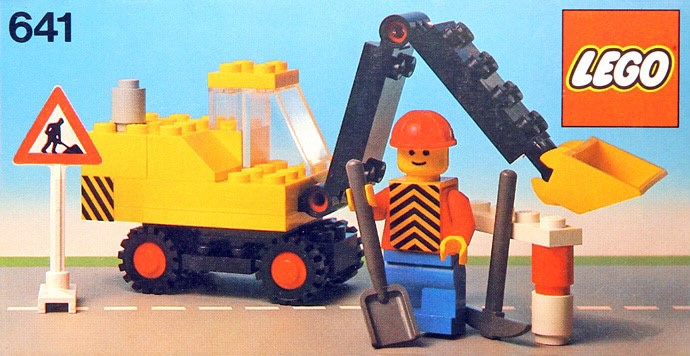



There were no criminals in LEGO Town at this stage: the police were more likely to be seen helping out broken down rally drivers rather than fighting crime. Indeed, the fire brigade never fought actual fire (in brick form) until the mid 2000s.

In 1978, we also saw the first of the Town Square type sets. With 478 elements, 1589 has the highest part count of a LEGO Town set during this period.

Enter the Eighties: Setting The Scale

We often talk about ‘Minifigure scale’ these days, however, in those early days of LEGO Town, the scaling of vehicles, in particular, was remarkably inconsistent. As we moved into the 1980s, things became a little more regulated: All new vehicles released at this time were able to be occupied by a Minifigure. This may not be in keeping with the proportions of their ‘real world’ equivalents, but there is a degree of consistency.
While the colour palette remains fairly consistent, some new elements come into play, which enhances the design of models in our town:
In 1980, we saw the arrival of the Ehrling Brick – also referred to as the washing machine or headlamp brick. This brick allows a new level of brick-built detail in the radiator grilles of vehicles: what was once a printed brick is now several parts, providing more realistic headlights.
By making sure that a Minifigure could sit inside the vehicles, we saw an increase in the height of typical vehicles, compared to vehicles from 1978, where a minifigure could not sit. (540 from 1978; 3323 from 1983)


This change in scale is subsequently reflected in the height of garages in sets of this era – the walls of the garage in 3682 (1981) are eight bricks high, compared with six bricks high in 374 (1978). This change was necessary if the garages were to house vehicles of the new scale.


1980: A Larger Wheel
A new wheel was introduced, allowing small trucks to, at least, feel as though they are bigger than cars. (6363 from 1980). With time, trucks improved in their appearance by the creative use of elements such as ladders as engine grilles (1572 from 1986; and above in 3682 from 1981)


1981: Finger Hinges:
Some of these vehicles featured a ‘finger hinge’ element – introduced in 1981, which also allowed a vehicle’s roof to be opened and place a minifigure into the driver’s seat:








1983: Motorcycles
The motorcycle was always a bit difficult to build realistically: the handlebars could not be gripped by Minifigure hands. In 1983, a new element was introduced. (603 from 1978, 6654 from 1983, Others from 1984)
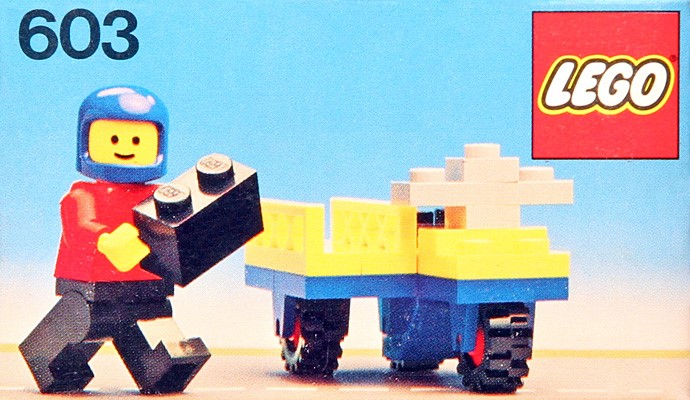

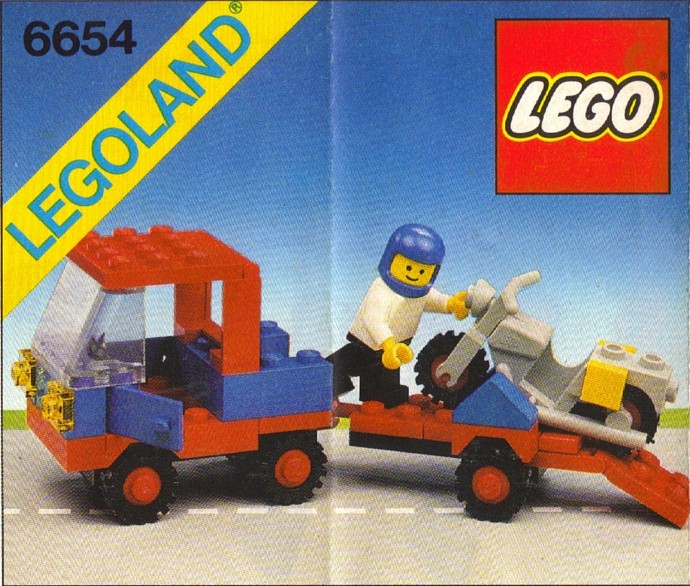



1984: Revolutionising Wheels:
The LEGO Wheels assembly, commonly used in LEGOLand sets, was relatively complex from a manufacturing perspective: A plate with holes, two wheels and tyres, joined together with a metal axle rod.
In 1984 a new system was introduced: a plate with small pins, which click into the wheels. This system remains the standard way to attach wheels today, although the range of plates with connectors has expanded over the years.
First appearing in 6655 (released in 1984), the new axle/wheel combination took off in 1985, where it appeared in 10 out of 17 sets featuring wheeled vehicles. The older plate/rod wheel combination would remain in use through to the 1990s. However, this new system offered the advantage from the manufacturer’s point of view. The wheel-tyre-axle element was no longer required to be assembled as a single element in the factory.





1985: Bring Out The Bikes
LEGO Town introduced Bicycles in 1985: a simple element that could not be readily brick-built. Predominantly introduced for touring, the post office also used bicycles.




1987: Brackets and Grille Tiles Bring Cars A More Detailed Front End.
In 1987, the introduction of brackets and grilles again revolutionised the front end of trucks and cars, increasing the variety of designs possible.


Panelling
It was not only in the construction of vehicles that we saw advances: We also saw the introduction of new 1x4x6 panelled windows and doors. These would simplify the construction of buildings, as you can see in these examples from 1982. Over the years, Town style sets will become more and more dependent on panels – either as full-height windows or opaque panels – for putting buildings together with ease.


1986: Sound and Light
It’s all very well having a static model, but why would you want something just standing quiet and still? In 1986, the introduction of Sound and Light systems breathed new life into the LEGO Police and Fire departments, with various sounds and flashing patterns. These elements spent a couple of years being used in Space sets before returning to LEGO Town in 1989:




Subject Matter: 1970s-80s?
Apart from Police and Fire sets, there were a few recurring businesses in the ’80s: Petrol Stations and repair shops were in abundance. We even saw many more Doctor’s offices, hospitals and trauma centres than we have in recent times. However, a trend that has changed in recent years has been incorporating small repair shops into larger businesses, possibly in a similar way to that we see in the real world.









Racing:
We also start to see race cars regularly, with the occasional raceway. (6609 from 1981; 6604 from 1985; 6381 from 1987). These range in complexity from the very simple to far more fantastic.



Logistics: Cargo and Mail centres
Logistics and mail services also began to make their presence felt around 1982(6362 Mail) and 1983(6624 – Cargo). Many of the logos featured in the signage here persisted for many years. International transport first appeared on LEGO Trains back in the train sets released in 1972, and it is nice to see that branding remembered in 6367. Before 6391 in 1984, helicopters had been the sole purview of the police, red cross and fire departments.



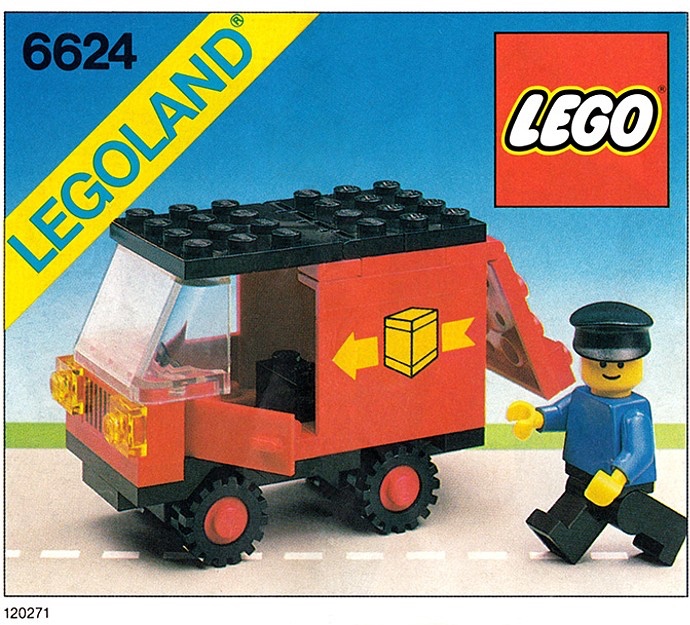



With the expansion of the cargo and logistics to include air travel, it was only a matter of time before we got our first airport, along with passenger planes. ‘Triple angled’ slopes and inverse slopes were introduced in 1985. These elements made the sleek, tapered appearance of the aeroplanes possible. These arrived in LEGO Town in 1985 and have remained a staple of ‘swooshable’ sets ever since.
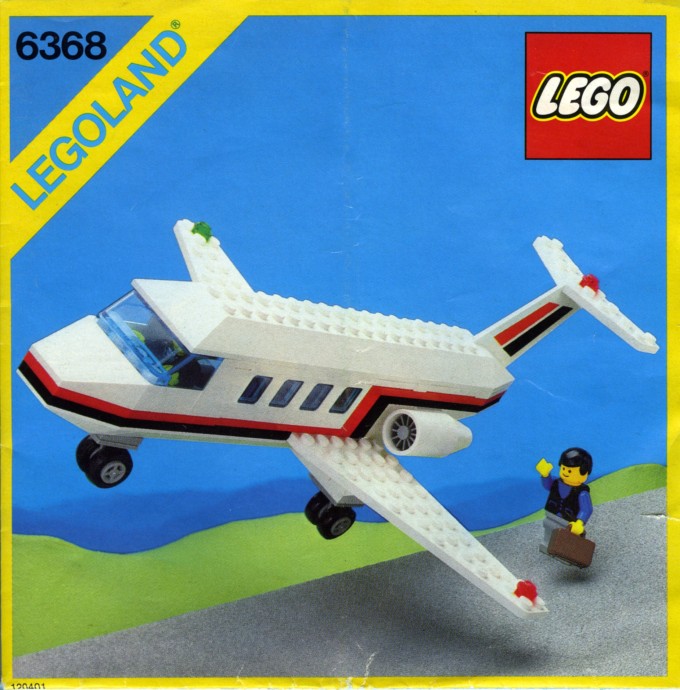


While wedge plates had been used in LEGO Space sets from 1978 on, these sets represent the first use of any elements specifically tapering in LEGO vehicles. In addition, these same elements allow the release of ‘buildable’ boat sets in LEGO Town, compared to the ‘floating’ boat hull system, which had been in use since the early ’70s. Until this time, LEGO Town was built on a grid, with the only non-90º angles being roof slopes, windscreens, and half open doors.






The windscreen element (4x3x1 1/3) underwent a couple of revisions early on, losing many of the studs, but the 1987 revision is still in use today.


Everyday People, Doing Everyday Things
We saw plenty of everyday people leading everyday lives. Houses were typical, with 11 different ones released from 1979-1989. The popularity of houses as a specific set would drop off in the 1990s… but more of that next time. There were many cars with trailers and caravans released during this time. Some of these sets have their paralells in Creator 3in1 or LEGO City today.


In 1988, we saw the ultimate vehicle combination: the Helicopter carried on the back of a truck. This gave kids a fantastic variety of play within the one set! This combination has recurred multiple times over the subsequent 30 years.

Into the ’90s: Expanding the Palette
Throughout the ’80s, sets have had the ‘LEGOLAND’ banner in the upper left-hand corner, continuing into 1990. The largest town sets of that year are also the most iconic: The Breezeway Cafe, International Airport and the Airport Shuttle monorail. These sets share a curved arch element – perhaps something that helps define this era: the arrival of external curves featured on the monorail shelter, the airport arrival gates, and the windows of the Breezeway cafe



As the 1990 sets rolled out, we already started to see some examples of the shape of things to come: 27º angled windscreens led to a sleek new range of vehicles, representing, in part, what we thought the near future had in store for us. As 1991 arrived, sets would lose the bright diagonal banner. (another element of interest in 6530 is the combination slope and wheel arch. This element will appear a few times during the ’90s)



New exhaust pipes resulted in a new generation of gas guzzling vehicles, possessing a near comical design aesthetic, but demonstrating a degree of versatility. Allow with the presence of the curves in in the buildings abve, we start to see a change in the degree of blockiness in these sets.


In conclusion:
From 1978 to 1990, heady development took place throughout the LEGO product lines, and LEGO Town was no exception.
As we have surveyed a selection of the Town sets from this era, we can see how set design evolved over this time: Initially, we saw minifigures included, regardless of the scale or design of the vehicle. However, with time, the scale became more consistent, and every vehicle would seat a Minifigure. New elements allowed new shapes to be built: defining the look of the era. The introduction of SNOT techniques allowed a greater level of detail to be included in vehicles.
Not all problems could be solved with clever building techniques, however, and we saw new elements developed for motorcycles and bikes. We also saw the adoption of a new wheel/axle arrangement, simplifying manufacture and allowing wheels. Light and sound elements added life to sets, although in limited numbers. Tapered slopes and plates allowed the development of aeroplane and boat models.
The subject matter of these sets is similar to what we see today in LEGO City. Police, fire, transport, service stations, road repair and racing cars. Perhaps we don’t see as many houses in LEGO City as we did in Town… but that is a discussion for the future.
Next time, in our exploration of classic themes, we shall look at how the Town sets evolved during the ‘System’ era – 1992-1999. There is a lot to see with a broader parts palette, new colours, new faces, and distinct sub-themes. I might even have some new reviews of old sets coming up soon.
If you want to be sure to catch the next installments in this story, be sure to follow The Rambling Brick- either sign up to our mailing list, or follow us on Facebook.
While you are here…
Have you been inspired by this trip down memory lane through LEGO Town in the 1980s? Would you like to contribute to our Builders’ Journeys column?
I believe everyone has a set from their past that is significant for some reason or another, whether it was their first, a set you built with your grandparents, a set you built with your own kids. It doesn’t matter if it is Town, Castle, Space, or even a licensed theme: If you can write a paragraph or two explaining why that set is special to you, why not send it in. If you do not have photos of it, do not worry: we can probably find some. Drop us an email at ramblingbrick@gmail.com, and until next time…
Play Well.
All images in this article were sourced from Brickset.com. Huw Millington has created a fantastic resource, including images of virtually all LEGO sets in the LEGO archives. This article would not be possible without this resource, gathering together box art, links to instructions, and minifigures. Some Images of Elements have been sourced from Bricklink.com.

Another most informative, pleasant to read presentation – thanks for the trip down memory lane.
[…] The Rambling Brick published beautiful article, which discusses in detail the development of the classic Lego city between […]
[…] occaisional series examining ‘Whatever Happened to Classic LEGO Themes?’ Previously, we took a look at the Classic town sets from 1978-1990. We examined the way that the theme was defined by certain colours, shapes, and […]
I love all Lego, and most themes but focus on town/city because of a keen interest in architecture as well as Lego itself. I have a lot of old sets from 1970’s 80’s growing up and these sets always bring back beautiful memories, and I get the purpose of this website. I love todays Lego ideas but it’s more complicated today, although better in a lot of ways. I do and always will go back to and reflect on the early town Lego, so full of colour and so many brilliant ideas, even back then, so simple and so exciting, and yes, something we could afford with our pocket money. The more expensive sets tended to come as Christmas gifts or birthday time, so that we could gradually build our simple town up. I’m glad I still have my early 70’s 80’s town, as well as a lot more besides now, but it’s always something I think that the best of us will keep feeling a special pull towards. Thanks for a warm and touching write up!
[…] aardig verhaal over Legoland in de periode dat het vrachtschip op de markt kwam (1987) is hier te vinden. Ik beschouw het als het verhaal van een waarnemer – er wordt geen […]
[…] the past 18 months, the Rambling Brick has looked at the development of Classic Town from the early days, through the System era, a World City inspired Dark Ages to LEGO® City we […]
[…] Minifigures arrived on the scene in 1978, we were presented with three settings: Castle, Town and Space – The Past, The Present and The Future. Through the 1980s, these themes developed in […]
[…] The Classic Town that many had grown up with was becoming an almost cartoonlike parody of itself. From 1978 through to the early ’90s, Town had a certain degree of simplicity, but with style. It was always striving to be its best, […]
[…] cities – both in real life and LEGO® Form. The first Minifigure Scale passenger planes debuted in the mid 1980s, and were relatively similar in design until 2006, with the arrival of large scale wing […]